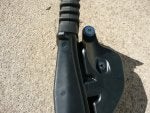Does anyone know if there is a reason the intake runners are so narrow, apart from clearing the fork tubes.
I'm just in the middle of fitting a K&N filter and the seem so narrow as to be ridiculous.
I'm almost tempted to get some spare runners, saw them off where they screw into the airbox and fit some screens.
I realise I would lose any ram air advantage but I'm wondering how much ram effect you get from such restrictive tubes.
They narrow to about 1' x 1 3/4' and that to me seems SMALL
We all go on about larger and larger exhausts to let the gas out but we dont seem concerned about letting them in. Maybe a slightly restricted intake increases air velosity, does that help? It would seem to be introducing pumping loss into the system
Any bright sparks out there with any ideas??
Cheers
Ross
I'm just in the middle of fitting a K&N filter and the seem so narrow as to be ridiculous.
I'm almost tempted to get some spare runners, saw them off where they screw into the airbox and fit some screens.
I realise I would lose any ram air advantage but I'm wondering how much ram effect you get from such restrictive tubes.
They narrow to about 1' x 1 3/4' and that to me seems SMALL
We all go on about larger and larger exhausts to let the gas out but we dont seem concerned about letting them in. Maybe a slightly restricted intake increases air velosity, does that help? It would seem to be introducing pumping loss into the system
Any bright sparks out there with any ideas??
Cheers
Ross









